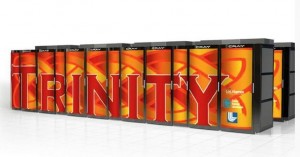 Today Cray announced the Company has been awarded one of the largest contracts in Cray’s history — a $174 million deal to provide the NNSA with a next generation Cray XC supercomputer. As part of the Trinity procurement, the 15 Megawatt supercomputer will be based on Intel Knights Landing.
Today Cray announced the Company has been awarded one of the largest contracts in Cray’s history — a $174 million deal to provide the NNSA with a next generation Cray XC supercomputer. As part of the Trinity procurement, the 15 Megawatt supercomputer will be based on Intel Knights Landing.
The next-generation Cray XC supercomputer will provide the NNSA with a world-class supercomputing system to advance the mission for the agency’s stockpile stewardship program. The system, named “Trinity” by the NNSA, is a joint effort between the New Mexico Alliance for Computing at Extreme Scale (ACES) at the Los Alamos National Laboratory and Sandia National Laboratories as part of the NNSA Advanced Simulation and Computing Program (ASC). The new Cray supercomputer will be used to ensure the safety, security and effectiveness of the United States’ nuclear stockpile.
Both Los Alamos and Sandia have a long history with Cray, going back to the beginning of the supercomputing era and most recently with the Cielo platform,” said Gary Grider, High Performance Computing Division Leader at Los Alamos. “That history continues with the Trinity platform that will provide next generation supercomputing in support of the U. S. nuclear security enterprise.”
The Trinity system will support all three of the NNSA national laboratories, which include Los Alamos National Laboratory, Sandia National Laboratories and Lawrence Livermore National Laboratory. The NNSA’s current supercomputer sited at Los Alamos is a Cray XE6(TM) system named “Cielo.” The new Trinity system is expected to deliver more than eight times greater applications performance than the Cielo system.
It is a real honor that one of the largest contracts in our Company’s history has come from one of our most important customers,” said Peter Ungaro, president and CEO of Cray. “Our partnership and collaboration with the NNSA has led to the development of groundbreaking supercomputing systems, including the Cray XT3 system that resulted from the Red Storm project. The NNSA has consistently deployed the world’s most advanced supercomputing systems to support their critical mission of ensuring the health of our nation’s nuclear stockpile. We couldn’t be more proud that, once again, the NNSA has placed its trust in Cray to provide them with the computational tools needed to support their important mission.”
Through a phased deployment, Cray will provide the NNSA with a multi-petaflop supercomputing system and a multi-petabyte Cray Sonexion storage system. The Trinity system will be a next-generation version of the Cray XC30 supercomputer, and will include future Intel Xeon processors code-named “Haswell” and future Inten Xeon Phi processors code-named “Knights Landing.” Trinity will be located at Los Alamos National Laboratory.
NNSA’s selection of the Cray XC supercomputer, powered by future Intel Xeon and Intel Xeon Phi processors, will deliver great application performance for a wide set of codes while the binary compatibility between the processors will allow the NNSA to reuse existing codes,” said Charles Wuischpard, vice president and general manager of Workstations and HPC at Intel. “Intel is excited to build upon our longstanding and successful collaboration with Cray to deliver this vanguard HPC system to the NNSA.”
The Cray Sonexion storage solution at NNSA will include 82 petabytes of capacity and 1.7 terabytes per-second of sustained performance. Cray’s Sonexion storage system combines Cray’s Lustre(R) expertise with a unique design that allows scalability from five gigabytes per-second to more than a terabyte per-second in a single file system — and performs optimally at scale. Management is simplified through an appliance design with all storage components including software, storage and infrastructure.
Previously code-named “Cascade,” the Cray XC30 series of supercomputers is engineered to meet the performance challenges of today’s most demanding high performance computing (HPC) users. The Cray XC30 and Cray XC30-AC supercomputers include: the Aries system interconnect; a Dragonfly network topology that frees applications from locality constraints; innovative cooling systems to lower customers’ total cost of ownership; the next-generation of the scalable, high performance Cray Linux Environment supporting a wide range of applications; Cray’s HPC optimized programming environment, and the ability to handle a wide variety of processor types.
Consisting of products and services, the multi-year, multi-phase contract is valued at more than $174 million in total, with substantial system acceptances expected to occur in both late-2015 and 2016.
Coming in the wake of the NERSC-8 Cori supercomputer announcement, this is the second major win in a row for Cray and Intel Knights Landing. For a TOP500 list that seemed to have stalled, I think the outlook for Cray is looking very bright indeed.




